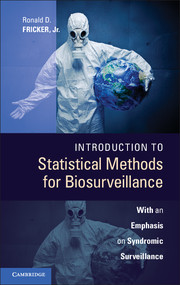Book contents
- Frontmatter
- Content
- Preface
- Acknowledgments
- Part I Introduction to Biosurveillance
- Part II Situational Awareness
- 3 Situational Awareness for Biosurveillance
- 4 Descriptive Statistics for Comprehending the Situation
- 5 Statistical Models for Projecting the Situation
- Part III Early Event Detection
- Part IV Putting It All Together
- Part V Appendices
5 - Statistical Models for Projecting the Situation
from Part II - Situational Awareness
Published online by Cambridge University Press: 05 March 2013
- Frontmatter
- Content
- Preface
- Acknowledgments
- Part I Introduction to Biosurveillance
- Part II Situational Awareness
- 3 Situational Awareness for Biosurveillance
- 4 Descriptive Statistics for Comprehending the Situation
- 5 Statistical Models for Projecting the Situation
- Part III Early Event Detection
- Part IV Putting It All Together
- Part V Appendices
Summary
Prediction is very difficult, especially about the future.
UnknownStatistical models are often used to formally characterize underlying relationships in data. In terms of situational awareness (SA), as the chapter title says, statistical models can be useful for projecting (i.e., forecasting) the current situation into the future. The goal is to provide a decision maker with an understanding of what the near-term trends are likely to be for a particular situation.
A benefit of statistical modeling, appropriately done, is that such models also provide estimates of forecast uncertainty. This is an important part of modeling that is sometimes overlooked or ignored. Simply put, a forecast without some quantification of the uncertainty inherent in the forecast is not particularly useful. Without the uncertainty quantification, a decision maker cannot know how much credence to give the forecast.
This chapter focuses on statistical models useful for the projection step of situational awareness, including time series and regression-based models. As described in Chapter 3, projection is the third and highest level of SA, involving the ability to project the future status of the elements in the environment.
- Type
- Chapter
- Information
- Introduction to Statistical Methods for BiosurveillanceWith an Emphasis on Syndromic Surveillance, pp. 111 - 146Publisher: Cambridge University PressPrint publication year: 2013



